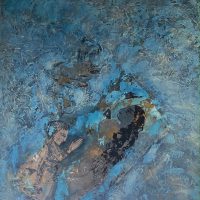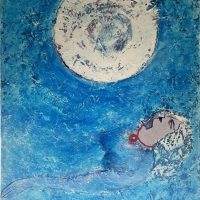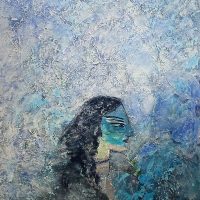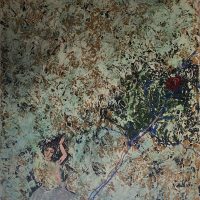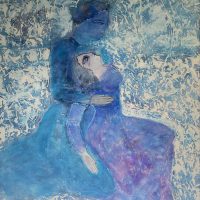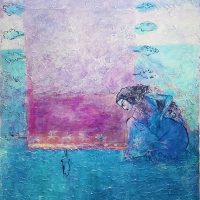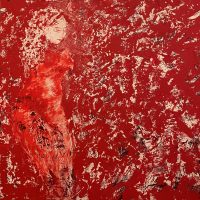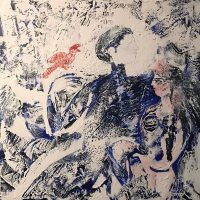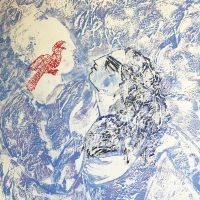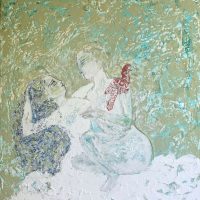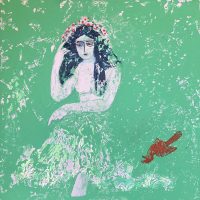
L’uomo moderno sente spesso la necessità di un recupero del proprio tempo, quasi come se questo non facesse altro che scivolare via in attimi che, vuoti di consapevolezza, si susseguano senza alcuna poesia. Tornare a riappropriarsi della propria dimensione intima tramite l’indagine di se stessi è un’esigenza legittima e da perseguire, che l’arte può favorire in modo del tutto spontaneo. Trovarsi davanti alle opere di Ronak Moshiri significa avere la possibilità di immergersi in una dimensione narrativa necessaria per lo spirito, in una tradizione che dai tempi più lontani guida l’uomo oltre le immagini e le parole, per ricongiungerlo, attraverso queste, con la parte più vera e significativa della propria anima. Fine cantastorie, l’artista si fa tramite della tradizione persiana in modo del tutto contemporaneo, mantenendone intatta la profondità lirica e la capacità introspettiva. Il trattamento del fondo pittorico permette l’emergere delle figure da una dimensione che non è solo materica ma spirituale, in cui gli elementi formali trovino adeguata collocazione. Agendo sulla materia con digressioni spesso monocromatiche l’artista crea una dimensione atemporale, all’interno della quale le figure possano fluttuare trovando riparo da un’esteriorità che sembra loro non appartenere. L’indagine artistica è per l’artista analisi interiore: lo spazio di azione, delimitato da un gesto avvolgente e circolare, si irradia partendo dal centro con la potenza e l’immediatezza di un ricordo che emerga, una volta lanciato il sasso nella quiete superficie della memoria, lasciando aloni luminosi a definirne le forme. La parola giunge a completare l’impianto compositivo, con eleganti inserimenti di poesia visiva che permettono a elementi immateriali e concreti di unirsi, in un equilibrato incontro tra laicità e sacralità. Le figure emergono come da una visione mistica, il bello si manifesta in forme simboliche che, trovando posto sulla tela, ricordano a chi guarda l’importanza del sentimento come primo mezzo per ricongiungersi con il divino: l’apparizione si fa poesia, la poesia estasi, e i contorni delle figure sprigionano energia creatrice. Se la lirica è la lingua di un mondo invisibile di cui, secondo la tradizione persiana, chi scrive è sovrano, la pittura traduce in luce e ombra le sfumature dell’interiorità più segreta, linguaggio mistico e sacrale, capace di interpretare e tramandare l’esperienza arricchente dell’ignoto. Nel suo Mathnawi il poeta Rumi sostiene che le parole siano nidi e “i significati alate creature già in volo. I corpi sono come dei fiumi e lo Spirito è la loro calma corrente.” Nelle opere di Ronak Moshiri è riposta una serenità che, attraverso il gesto artistico, riconduce al confronto con il nostro intimo più vero e la priorità di riscoprirne l’essenza più autentica, rivelandoci nel contempo l’esistenza di un mondo salvifico che c’era una volta ma può e deve essere ancora parte integrante dell’esistenza dell’uomo.
Francesca Bogliolo
Modern man feels the necessity to take his time back, almost as if it always try to slip away in moments which, empty of awareness, one follows another with no poetry. Getting our own inner dimension back through the investigation of oneself is a rightful necessity and that has to be pursued, which art can facilitate in a completely natural way. Facing Ronak Moshiri’s works means to have a possibility to dive in a narrative dimension essential for the soul. In a tradition that since the furthest times leads man beyond images and words, to reunite him, through these, with the most true and significant part of his own soul. Distinguished storyteller, the artist is the link to the Persian tradition in a completely contemporary way, preserving its lyrical depth and introspective ability. The treatment of the pictorial background makes the figures stand out from a dimension that doesn’t pertain only to matter but that is also spiritual, where formal elements find their appropriate place. Working on matter with deviations frequently monochromatic the artist creates a timeless dimension, inside which the figures can float taking shelter from an exterior which seems not belonging to them. The artistic research is for the artist an introspective analysis: the space for action, limited by an enveloping and circular gesture, radiates from the centre with the power and the immediacy of a memory that comes back to mind, once the stone is thrown in the stillness of the memory’s surface, leaving a bright halo to define forms. The word is used to complete the compositional system, with refined inserts of visual poetic which makes intangible elements join together, in a balanced meeting between laity and sanctity. Figures come to the surface as from a mystic vision, beauty reveal itself in symbolic shapes which, finding a place on the canvas, remember to the viewer the importance of feelings as the first means to rejoin with the divine: appearance becomes poetry, poetry becomes ecstasy, and the outlines of figures emanate creative energy. If lyric is the language of an invisible world where, according to the Persian tradition, who writes is sovereign, painting converts in light and shadow the shades of the most hidden inner self, mystic and sacral language, able to interpret and pass on the enriching experience of the unknown. In his Mathnawi the poet Rumi stated that words are nests and “meanings are winged creatures already flying. Bodies are like rivers and the Soul is their peaceful flowing.” In Ronak Moshiri’s works there is a serenity that, through the artistic gesture, brings again to the confrontation with our most true inner self and the priority of rediscovering its most authentic essence, revealing to us at the same time the existence of a salvific world that once upon a time but can and must be still an integral part of the human existence.
Francesca Bogliolo


